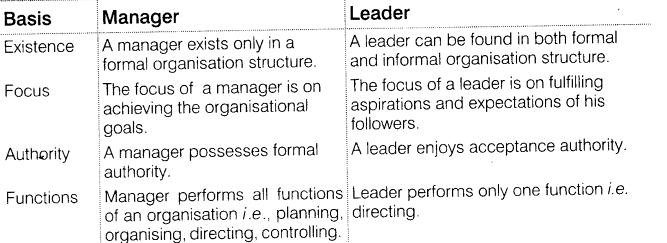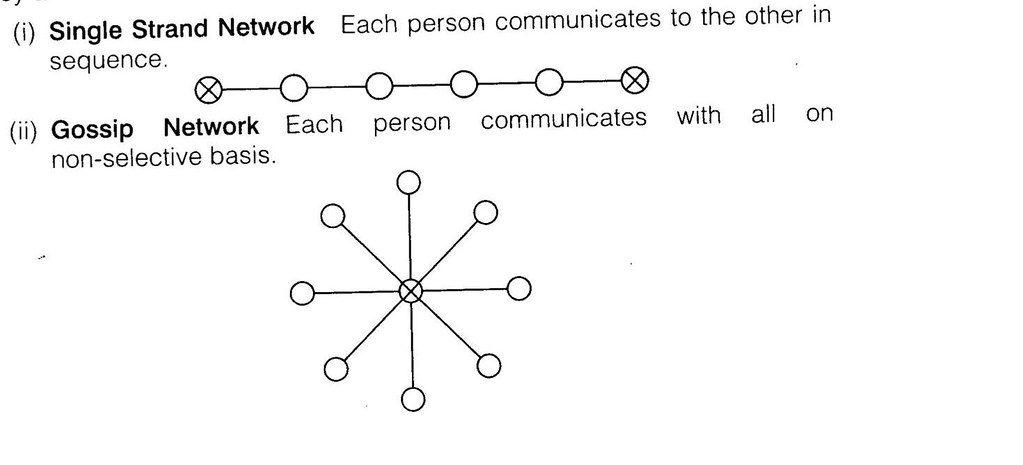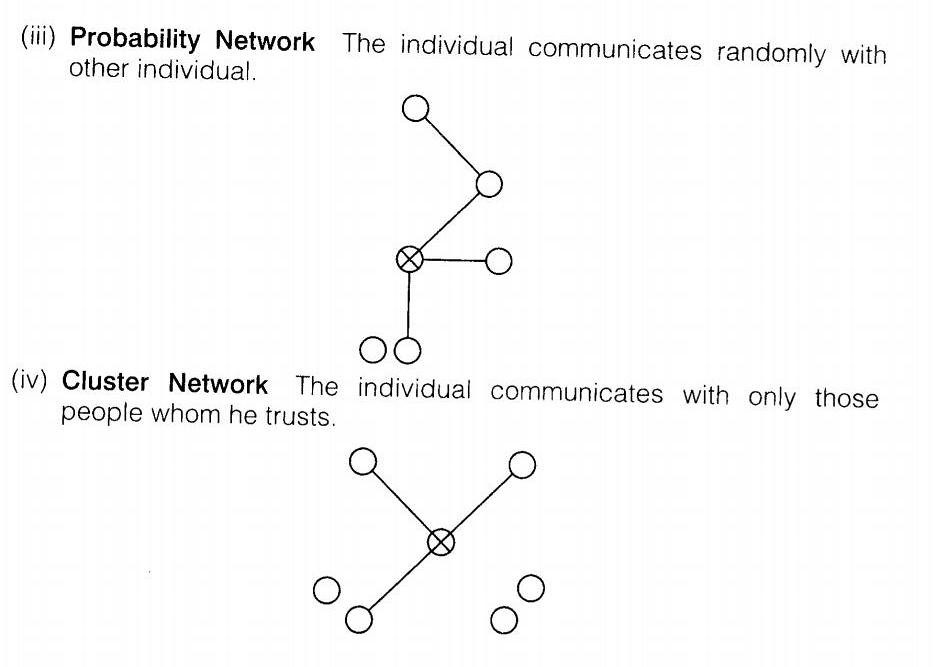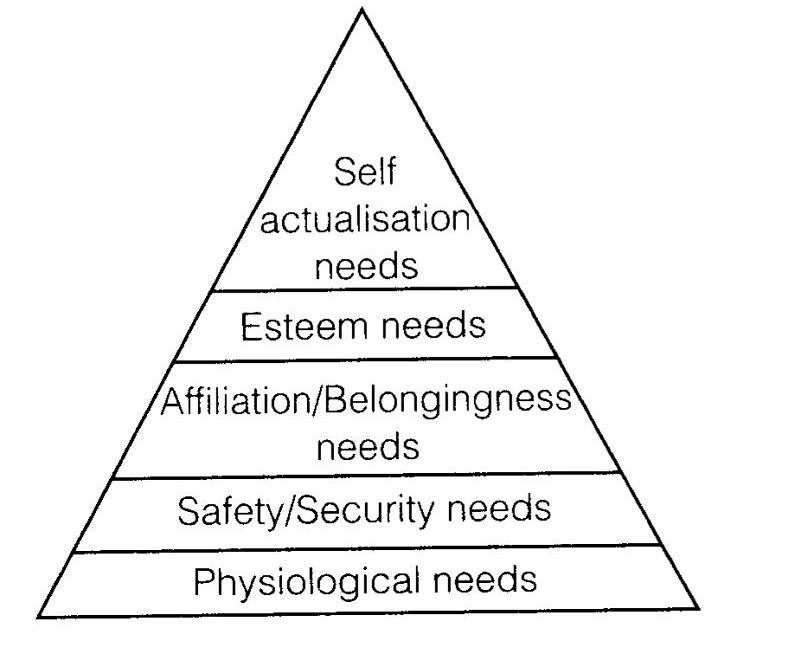Short Answer Type Questions
1. Distinguish between leaders and managers.
Ans: Difference between Managers and Leaders
2. Define Motivation.
Ans: Motivation is defined as inducing, inspiring and stimulating a person to perform with their best ability, to accomplish the goal. It depends upon satisfying needs of people. In the words of Farland, “motivation is the way in which urges, desires, aspirations or needs, direct control and explain the behaviour of human beings”.
3. What is informal communication?
Ans: The social interactions, gossips, friendly talks and non official matters which are discussed among different members of organisation who are not officially recognised is known as informal communication or we can say the communication that takes place without following the formal guidelines of communication is said to be informal communication. This type of communication establishes the personal relationship among employees. It is flexible, dynamic and no records of information communication are maintained under this Informal communication system is generally referred to as “Grapevine”.
4. What are semantic barriers of communication?
Ans: While communicating a message, misrepresentation of communication causes misunderstanding on account of use of wrong words lack of vocabulary skills, faulty translations, different interpretations is known as semantic barriers. It is concerned with the problems which arises in the process of encoding and decoding of message into words or impressions. Main causes of semantic barriers are listed below
(i) Badly expressed message
(ii) Symbols with different meanings
(iii) Faulty translations
(iv) Unclarified assumptions
(v) Technical jargon
(vi) Body language and gesture decoding
5. Who is a supervisor?
Ans: Supervision means instructing, guiding, monitoring motivating and observing the activities of employees from over and above. The person who is performing the work of supervision is known as supervisor. Supervisor is the link between management and subordinates. He is the person who translates the policies and plan of management to the subordinates and revert back the complaint, suggestions and feedback of subordinates to management.
6. What are the elements of directing?
Ans: Directing comprises of four elements
(i) Supervision It can be understood as the process of guiding and instructing the efforts of employees.
(ii) Motivation The process of encouraging the employees in order to help them in achieving the desired goals is known as motivation.
(iii) Leadership It is the process of influencing the behaviour of people by making them strive voluntarily towards achievement of organisational goals.
(iv) Communication It is the process of exchange of ideas, views, facts, feelings etc between or among people to create common understanding.
7. Explain the process of motivation.
Ans: Motivation process is based on how unsatisfied human need gets satisfied and results in reduction of tension.
The steps of motivation process are as follows
(i) Unsatisfied Need The need of an individual which is not satisfied.
(ii) Tension Unsatisfied need creates tension.
(iii) Drive This tension creates drive and an individual starts looking for alternatives to satisfy the need.
(iv) Search Behaviour Then he starts behaving as per chosen option.
(v) Satisfied Need After opting the chosen behaviour his need got satisfied.
(vi) Reduction of Tension The fulfillment of need results in relieving of tension.
8. Explain different networks of grapevine communications.
Ans: Grapevine communications may follow different types of network they are
Long Answer Type Questions
1. Explain the principles of Directing.
Ans: Principles of Directing
(i) Maximum Individual Contribution
This principle emphasises that directing techniques must help every employee to contribute to his maximum potential in order to achieve the organisational goals. It should help in bringing out unused or dormant potential of an employee to improve the efficiency of the organisation, e.g., suitable and appropriate incentives should be given to encourage employees to improve their performance.
(ii) Harmony of Objectives Most of the time it happens that the organisational objectives and individual objectives move in opposite directions. The person in charge of a team of workers should guide and instruct his team in such a manner that they realise the importance of both the objectives.
(iii) Unity of Command This principle insists that a person in the organisation should receive instructions from one superior only. If instructions are received from more than one, it creates confusion, conflict and disorder in the organisation. Adherence to this principle ensures effective direction.
(iv) Appropriateness of Direction Technique According to this principle, appropriate motivational and leadership technique should be used while directing the people based on subordinate needs, capabilities, attitudes
etc, e.g., combination of both monetary and non-monetary incentives should be used to elicit the right response from the employees.
(v) Managerial Communication Directing should convey clear instructions to create total understanding to subordinates. Through proper feed back the manager should ensure that subordinate understands his instructions clearly.
(vi) Use of Informal Organisation Informal groups or organisations exist within every formal organisation and every manager should spot and make use of such organisations for effective directing.
(vii) Leadership While directing the subordinates managers should exercise good leadership as it can influence the subordinates positively without causing dissatisfaction among them.
(viii) Follow Through Mere giving of an order is not sufficient. Managers should follow it up by reviewing continuously whether orders are being implemented accordingly or any problems are being faced by the subordinates.
2. Explain the qualities of a good leader. Do the qualities alone ensure leadership success?
Ans: Some of the qualities required by all leaders are
(i) Physical Features
It is believed that good physical features attract people. Height, weight, health, appearance determine the physical personality of an individual.
(ii) Knowledge A good leader should have required knowledge and competence. Only such person can instruct subordinates correctly and influence them.
(iii) Integrity He should be a role model to other regarding the ethics and values. A leader should possess high level of integrity and honesty.
(iv) Initiative A good leader never waits for opportunities to come to his way rather he grabs the opportunity and use it to the advantage of organisation.
(v) Communication and Motivation Skills A leader should be a good communicator. He should have the capacity to explain his ideas and make the people to understand his ideas. He should also understand the needs of people and motivate them through satisfying their needs.
(vi) Self Confidence A high level of self confidence is very important for any leader. He should not loose his confidence even in most difficult times. A person who is not himself confident will never be successful in providing confidence to his followers.
(vii)Decisiveness Leader should be able to take decisions while managing the work. Once he is convinced about a fact, he should be firm and should not change opinions frequently.
(viii) Social Skills A leader should be sociable and friendly with his colleagues and followers. He should understand people and maintain good human relations with them.
Many times, the success of an organisation is attributed to the leader, but due credit is not given to the followers. Many followers related factors like their skills, knowledge, commitment, willingness to co-operate team spirit etc make a person an effective leader. It is said that followers make a person, a good leader by acceptance of leadership. Therefore both followers and leaders are playing an vital role in leadership process.
3. Discuss Maslow’s need Hierarchy theory of motivation.
Ans: Maslow’s need Hierarchy Theory of Motivation Motivation is a psychological term and the needs of an employee plays an important role in motivation. In order to study motivation various researchers developed theories on them. Among them Abraham Maslow’s need Hierarchy theory is considered of worth. As per him, their exists a Hierarchy of five needs these are
(i) Basic Physiological Needs These needs are most basic in the hierarchy and corresponds to primary needs. Food, clothing shelter are a few examples of this type of need. Basic salary helps to fulfill these needs.
(ii) Safety/Security Needs When the basic needs satisfied, people start thinking of future. These needs provide security and protection from physical and emotional harm in coming future e.g., job security, pension plans etc.
(iii) Affiliation/Belonging Need These needs refer to human feeling of belongingness. We all as human beings look forward to being accepted in the society e.g., friendship.
(iv) Esteem Needs These include factors such as self-respect, autonomous status, attention. An individual wants a respect and recognition from others in this need.
(v) Self-actualisation Needs It is the highest level of need in the hierarchy. It refers to the drive to become what one is capable of becoming. The needs include growth self-fulfillment and achievement of goals etc.
4. What are the common barriers to effective communication suggest measures to overcome them?
Ans: Common Barriers to Effective Communication Managers in all organisations face problems due to communication barriers. These barriers may prevent a communication or filter part of it or carry incorrect meaning due to which misunderstanding may be created. Therefore all managers should take some steps to overcome these barriers.
There are broadly four groups of barriers
(i) Semantic Barriers Semantic barriers are concerned with problems and obstructions in the process of encoding and decoding of message into words or impressions. Normally, such barriers result on account of use of wrong words, faulty translations, different interpretations etc. These are discussed below
(a) Badly Expressed Message Sometimes the message is not communicated correctly by the manager because of inadequate vocabulary, usage of wrong words, omission of needed words etc.
(b) Symbols with Different Meaning A word may have several meanings. Receiver has to perceive one such meaning for the word used by communicator.
(c) Faulty Translations Sometimes while translating if incorrect translation is done due to poor command over both the languages then meaning of the message changes. This leads to cause different meanings to the communications.
(d) Unclarified Assumptions Sometimes communication may have certain assumptions which are subject to different interpretations The one should always clear the meaning of what he is instructing the worker to do, so that the worker has no doubts in his mind.
(e) Technical Jargon Sometimes specialists may use technical words in their communication by which the receiver is not aware.
Therefore, they may not understand the complete conversation.
(f) Body Language and Gesture Decoding The body movement and body gestures plays an important role in conveying the message.
If there is no match between what is said and what is expressed in body movements, communications may be wrongly perceived.
(ii) Psychological Barriers
Emotional or psychological factors acts as barrier to communications e.g., a person who is worried cannot understand what is being told. Some of the psychological barriers are
(a) Premature Evaluation Sometimes people evaluate the meaning of message before the sender completes his message. Such premature evaluation may be due to pre-conceived notions.
(b) Lack of Attention If the mind is pre-occupied then the result is non-listening of message by receiver act as a major psychological barrier.
(c) Lon by Transmission and Poor Retention When message passes through various levels, successive transmission of message results in loss of information. It happenes mostly with oral communication. Also people cannot retain the information for a long time if they are inattentive or not interested.
(d) Distrust If the communicator and communicatee do not believe on each other, they can not understand each others message in its original sense as they are not giving importance to the information exchanged.
(iii) Organisational Barriers The factors related to organisation structure, authority relationships, rules and regulations may sometimes act as barriers to effective communication some of these barriers are
(a) Organisational Policy If the organisational policy is not supportive to free flow of communication, it may hamper effectiveness of communications.
(b) Rules and Regulations Rigid rules and cumbersome procedures may be a hurdle to communication similarly, communication through prescribed channel may result in delays.
(c) Status Status of superior may create psychological distance between him and his subordinates. The people working at higher level may not allow his subordinates to express their feelings freely.
(d) Complex Organisational Structure In an organisation where there are number of managerial levels, communications gets delayed and distorted as number of filtering points are more.
(e) Organisational Facilities For smooth clear and timely communication proper facilities are required like frequent meetings suggestion box, internet connection, inter-com facility. Lack or ineffectiveness of these facilities may create communication problems.
(iv) Personal Barriers
The personal factors of both sender and receiver may exert influence on effective communication. Some of the personal barriers are
(a) Fear of Challenge to Authority If a superior feels that a particular communication may affect his authority negatively then he/she may not speak it out clearly and openly.
(b) Lack of Confidence of Superior on his Subordinate If superiors do not have confidence on their subordinates, they may not seek their advice or opinions.
(c) Unwillingness to Communicate Sometime subordinator may not be prepared to communicate with their superiors, if they think that it may adversely affect their interests.
(d) Lack of Proper Incentives If there is no reward for communication then employees may not be motivated to communication, e.g., if there is no reward or appreciation for a good suggestion, the subordinate may not be willing to offer useful suggestions again.
Some measures which can be adopted by organisations to improve communications are
(i) Clarify the Ideas Before Communication The entire message to be communicated should be studied in depth, analysed and stated in such a manner that it is clearly conveyed to subordinates. The message should be encoded in simple language which is understandable.
(ii) Communication According to the Needs of Receives All managers should be aware of the understanding level of his/her subordinates. He should adjust his communication and select the words according to the education and understanding levels of subordinates
(iii) Consult Others Before Communicating Before communicating anything, others who are linked with it in some way or the other should be taken into confidence for developing a better plan.
(iv) Beaware of Languages, Tone and Content of Message
The language used for communication should be understandable to the listener. The tone of the appropriate and the matter should not be offending to anyone.
(v) Convey Things of Help and Value to Listener
It is always better to know the interests of the people with whom you are communicating. If the message relates directly or indirectly to such interests and needs it certainly evokes response from communicatee.
(vi) Ensure Proper Feedback
The receiver of communication may be encouraged to respond to communication. The communication process may be improved by the feedback received to make it more responsive.
(vii) Follow up Communication
There should be a regular follow up and review on the instructions given to subordinates. Such follow up measures help in removing hurdles if any in implementing the instructions.
(viii) Be a Good Listener
Manager should be a good listener. Patient and attentive listening solves half of the problems. Managers should also give indications of their interest in listening to their subordinates
5. Explain different financial and non-financial incentives used to motivate employees of a company.
Ans: Financial Incentives Financial incentives refer to incentives which are in direct monetary form or measurable in monetary term and serve to motivate people for better performance. The financial incentives used in organisations are listed below
(i) Pay and Allowances For every employee, salary is the basic monetary incentive. It includes basic pay, DA and other allowances. Salary system consists of regular increments in the pay every year and enhancement of allowances from time to time.
(ii) Productivity Linked Wage Incentives Several wage incentives aim at linking payment of wages to increase in productivity at individual or group level.
(iii) Profit Sharing Profit sharing is meant to provide a share to employees in the profits of the organisation. This serves to motivate the employees to improves their performance and contribute to increase in profits.
(v) Co-Partnership/Stock Option Under these incentives schemes, employees are offered company shares at a set price which is lower than market price. The allotment of shares creates a peeling of ownership to the employees and makes them to contribute more for the growth of the organisation.
(vi) Retirement Benefits Several retirement benefits such as provident fund, pension and gratuity provide financial security to employees after their retirement. This act as an incentive when they are in service in the organisation.
(vii) Perquisites
In many companies perquisites and fringe benefits are offered such as car allowance, housing, medical aid, and education etc over and above the salary. These measures help to provide motivation to the employees/managers.
Non-financial Incentives
Incentives which help in fulfilling our psychological, emotional and social needs are known as non-financial incentives. Some of the non-financial incentives are
(i) Status Status means ranking or high positions in the organisation. Whatever power position prestige an employee enjoys in the organisation are indicated by his status. Psychological, social and esteem needs of an individual are satisfied by status given to their job.
(ii) Organisational Climate This indicates the characteristics which describe an organisation and distinguish one from the other. Individual autonomy, reward orientation, consideration to employees, etc are some of the positive features of an organisation. If managers try and include more of these in an organisation helps to develop better organisational climate.
(iii) Career Advancement Opportunity Managers should provide opportunity to employees to improve their skills and be promoted to the higher level jobs appropriate skill development programmes and sound promotion policy will help employees to achieve promotions. Promotions have always worked as tonic and encourages employees to exhibit improved performance.
(iv) Job Enrichment Job enrichment is concerned with designing jobs that include greater variety of work contentment, require higher level of knowledge and skill, give workers more autonomy and responsibility and provide opportunity for personal growth and a meaningful work experience.
(v) Employee Recognition Programmes Recognition means acknowledgement with a show of appreciation. When such appreciation is given to the work performed by employees, they feel motivated to perform/work at higher level, e.g.,
(a) Congratulate the employee
(b) Displaying names of star performers
(c) Installing awards
(d) Distributing mementos
(vi) Job Security
Employees want their job to be secure. They want certain stability about future income and work so that they do not feel worried on these aspects and work with greater zeal. There is only one problem with this incentive i.e., when people feel that they are not likely to lose their jobs, they may become relaxed.
(vii) Employee Participation
It means involving employees in decision making of the issues related to them. In many companies, these programmes are in practice in the form of joint management committees, work committees canteen committees etc.
(viii) Employee Empowerment
Empowerment means giving more autonomy and powers to subordinates. Empowerment makes people feel that their jobs are important. This feeling contributes positively to the use of skills and talents in the job performance.
Application Type Questions
1. The workers always try to show their inability when any new work is given to them. They are always unwilling to take up any kind of work. Due to sudden rise in demand a firm wants to meet excess orders. The supervisor is finding it difficult to cope up with the situation. Suggest ways for the supervisor to handle the problem.
Ans: The supervisor can take help of monetary incentives to motivate the workers. Their wages can be linked to productivity, they can earn more incentives besides wages by producing goods. Supervisor should also play the role of a good leader and encourage them to accept any kind of work as it would lead to increase exposure to the industry and better job prospects.
2. Workers of a factory often come to the production manager with the grievances. The production manager finds himself overburdened with so many tasks advise a way to relieve the production managers.
Ans: To overcome the problem, the production manager should take the following measures
(i) Arrange necessary training programmes
(ii) Prepare a work schedule.
(iii) Recommend the cases of the workers for promotion, rewards, transfer, punishment etc.
(iv) Proper availability of materials, machines and tools for the workers.
(v) Delegate sum of his authorities.
3. In an organisation employees always feel they are under stress. They take last initiative and fear to express their problems before the manager. What do you think is wrong with the manager?
Ans: The manager should adopt more friendly approach towards the workers. The manager should encourage a system of two-way communication, provide an outlet to workers to share their feelings, suggestions and problems.
4. In an organisation all the employees take things easy and are free to approach anyone for minor queries and problems. This has resulted in everyone taking to each other and thus resulting in inefficiency in the office. It has also resulted in loss of secrecy and confidential information being leaked out. What system do you think the manager should adopt to improve communication?
Ans: Excess of everything is bad. More use of informal communication is resulting in this problem. A proper chain of command should be established. Only the necessary information should be passed through chain of command The employees will not be allowed to communicate at all levels. This will save time and more discipline.
Case Problem
Y limited is a bank functioning in India. It is planning to diversify into increase business. Lately, the Government of India has allowed the private sector to gain entry in the increase business. Previously, it was the prerogative of LIC and GIC to do insurance business. But now with liberalisation of the economy and to make the field competitive other compnies have been given licenses to start insurance business under the regualtion of Insurance Regulatory and Development Authority’.
Y limited plans to recruit high quality employees and agents and exercise effective direction to capture a substantial part of life and non-life insurance business.
1. Identify how the company can supervise its employees and agents effectively. What benefits will the company derive from effective supervision?
Ans: The company can supervise its employees and agents by taking the following steps
(i) Training programmes should be organised.
(ii) Make them understand the various policies so that they can convince their clients.
(iii) Establishing targets for them and also monetary incentives.
(iv) Regularised system for submission of periodical reports of their performance.
The benefits of the above steps will be
(i) Trained personnel will give better performance. They can improve upon their skills.
(ii) Knowledge of the products of the insurance company will ensure better satisfaction for the clients.
(iii) They will compete to give better performance and earn higher incentives.
(iv) It will help in identifying the areas where workers and agents need specialised training programmes.
2. What financial and non financial incentives can the company use for employees and agents separately to motivate them. What benefits company will get from them?
Ans: Incentives for Employees
(i) Financial
(a) Productivity linked wage incentive
(b) Bonus
(c) Co-partnership
(d) Employee stock option
(ii) Non-financial
(a) Job-security
(b) Status
(c) Employee empowerment
(d) Employee recognition programme
Incentives for Agents
(i) Financial
(a) Commission (b) Bonus like paid vacation
(ii) Non-financial Incentive
(a) Cordial relationship
(b) Career advancement opportunity
(c) Job enrichment
(d) Recognition programmes like certificate of merit etc.
(e) Company achieves the motivation among the employees and they will contribute more in achieving targets.
3. How can the company ensure that higher order needs z. e., the esteem and self actualisation needs are met?
Ans: The higher order needs can be satisfied through
(i) Career advancement opportunity
(ii) Assignment of challenging job
(iii) Perquisites
(iv) Participation in management decisions
4. Identify the qualities of leadership in this line of business that the company manager must possess to motivate employees and agents.
Ans: The qualites of leaders which the manager of the insurance company must possess are
(i) Intelligence
(ii) Good communication skills
(iii) Self confidence, integrity and honesty
(iv) Good listener
(v) Pleasing personality
5. Give a model of formal communication system that the company can follow. Identify the barriers in this model, how can they be removed?
Ans: The most suitable model for formal communication
Barriers to Effective Communication
(i) Barriers Due to Organisational Structure
An organisational structure is complex with numerous levels in between which creates distance between the top management and the workers. With long lines of communication, there is possibility of message losing its significance.
(ii) Psychological Barriers
Every one perceives information in the light of their own experiences, prejudices and thinking.
(iii) Inability to Communicate
The lack of ability to communicate leads to misunderstanding and confusion. Different people have different meaning for same words.
(iv) Status and Position
Sometimes, effective flow of communication is hampered by status and position of the sender and receiver.
Measures to Overcome the Barriers
(i) Clarity in the thoughts of the sender is must for effective communication.
(ii) The sender should try to make the message meaningful and understandable.
(iii) Message should be precise and to the point.
(iv) The sender should always take the feedback from the receiver.
6. How can informal communication help to supplement formal communication model given by you in answer to question?
Ans: Informal communication takes place outside the official channels of communication. It fills the gaps that might exist in the formal communication. Merits of Informal communication are
(i) It helps the members to discuss the matters which cannot be discussed at the official level.
(ii) It is a way of knowing the reactions and opinions of the people about a change.
(iii) It helps in building team spirit.
(iv) The information flows at a faster speed.








